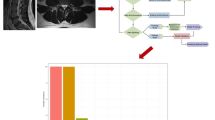Abstract
Purpose
A CAD system for lumbar disc degeneration and herniation based on clinical MR images can aid diagnostic decision-making provided the method is robust, efficient, and accurate.
Material and methods
A Bayesian-based classifier with a Gibbs distribution was designed and implemented for diagnosing lumbar disc herniation. Each disc is segmented with a gradient vector flow active contour model (GVF-snake) to extract shape features that feed a classifier. The GVF-snake is automatically initialized with an inner boundary of the disc initiated by a point inside the disc. This point is automatically generated by our previous work on lumbar disc labeling. The classifier operates on clinical T2-SPIR weighted sagittal MRI of the lumbar area. The classifier is applied slice-by-slice to tag herniated discs if they are classified as herniated in any of the 2D slices. This technique detects all visible herniated discs regardless of their location (lateral or central). The gold standard for the ground truth was obtained from collaborating radiologists by analyzing the clinical diagnosis report for each case.
Results
An average 92.5% herniation diagnosis accuracy was observed in a cross-validation experiment with 65 clinical cases. The random leave-out experiment runs ten rounds; in each round, 35 cases were used for testing and the remaining 30 cases were used for training.
Conclusion
An automatic robust disk herniation diagnostic method for clinical lumbar MRI was developed and tested. The method is intended for clinical practice to support reliable decision-making.
Similar content being viewed by others
Explore related subjects
Discover the latest articles, news and stories from top researchers in related subjects.References
An H, Anderson P, Haughton V, Iatridis J, Kang J, Lotz J, Natarajan R, Oegema T, Roughley P, Setton L, Urban J, Videman T, Andersson G, Weinstein J (2004) Introduction. disc degeneration: summary. Spine 29: 2677–2678
NINDS (2008) National institute of neurological disorders and stroke (ninds): low back pain fact sheet, NIND brochure
iCAD (2009) Spectra look digital from icad, Computer aided diagnosis, http://www.icadmed.com/breastmri.htm
iCAD (2009) Vivid look from icad, Computer aided diagnosis, http://www.icadmed.com/prostatemri.htm
Corso JJ, Alomari RS, Chaudhary V (2008) Lumbar disc localization and labeling with a probabilistic model on both pixel and object features. In Proceedings of MICCAI. vol 5241 of LNCS Part 1, pp 202–210, Springer
Alomari Raja’ S, Corso Jason J, Chaudhary V (2009) Abnormality detection in lumbar discs from clinical mr images with a probabilistic model, In Proceedings of CARS
Alomari Raja’ S, Corso Jason J, Chaudhary V, Dhillon G (2009) Desiccation diagnosis in lumbar discs from clinical mri with a probabilistic model, In Proceedings of ISBI’09, pp 546–549
Alomari Raja’ S, Corso Jason J, Chaudhary V, Dhillon G (2009) Computer-aided diagnosis of lumbar disc pathology from clinical lower spine mri. Int J Comput Assist Radiol Surg (in press)
Alomari Raja’ S, Corso Jason J, Chaudhary V, Dhillon G (2010) Automatic diagnosis of disc herniation with shape and appearance features from mri, In Proceedings of SPIE’10, to appear
Xu Chenyang, Prince Jerry L (2000) Handbook of medical imaging. Academic Press, Baltimore, pp 159–169
Swarm (2007) Interactive incorporation (viewmedica)—patient educatuion system
Fardon David F, Milette Pierre C (2001) Nomenclature and classification of lumbar disc pathology. SPINE 26(5): E93–E113
Fardon David F, Milette Pierre C (2001) Nomenclature and classification of lumbar disc pathology, AJNR, http://www.asnr.org/spine_nomenclature/glossary.shtml
Snell Richard S (2007) Clinical Anatomy by Regions, Lipp. Will. and Wilkins, 8th edn
Bounds DG, Lloyd PJ et al (1988) A multilayer perceptron network for the diagnosis of low back pain, In Proceedings of Conference on Neural Networks, San Diego, CA, July vol 2, pp 481–489.
Vaughn M (2000) Using an artificial neural network to assist orthopaedic surgeons in the diagnosis of low back pain, in http://www.marilyn-vaughn.co.uk/lbpainresearchstudy.htm, Dept. of Inf., Cranfield University (RMCS), June 2000
Tsai M et al (2002) A new method for lumbar herniated inter-vertebral disc diagnosis based on image analysis of transverse sections. CMIG 26(6): 369–380
Michopoulou SK, Costaridou L, Panagiotopoulos E, Speller R, Panayiotakis G, Todd-Pokropek A (2009) Atlas-based segmentation of degenerated lumbar intervertebral discs from mr images of the spine. IEEE Trans Biomed Imaging 56(9): 2225–2231
Alomari Raja’ S, Corso Jason J, Chaudhary V (2010) Labeling of lumbar discs using both pixel- and object-level features with a two-level probabilistic model. IEEE Trans Med Imaging (in press)
Liu F, Zhao B, Kijewski PK, Wang L, Schwartz LH (2005) Liver segmentation for ct images using gvf snake. Med Phys 32(12): 3699–3706
Videman T, Batti MC et al (2006) Determinants of the progression in lumbar degeneration: a 5-year follow-up study of adult male monozygotic twins. Spine 31: 671–678
Niemeläinen R, Videman T et al (2008) Quantitative measurement of intervertebral disc signal using mri. Clin. Rad 63(3): 252–255
Mulconrey D, Knight R (2006) Interobserver reliability in the interpretation of diagnostic lumbar mri and nuclear imaging. Spine 6: 177–184
Author information
Authors and Affiliations
Corresponding author
Rights and permissions
About this article
Cite this article
Alomari, R.S., Corso, J.J., Chaudhary, V. et al. Toward a clinical lumbar CAD: herniation diagnosis. Int J CARS 6, 119–126 (2011). https://doi.org/10.1007/s11548-010-0487-7
Received:
Accepted:
Published:
Issue Date:
DOI: https://doi.org/10.1007/s11548-010-0487-7




